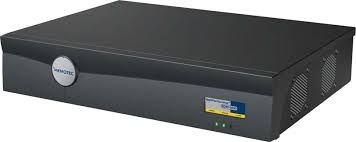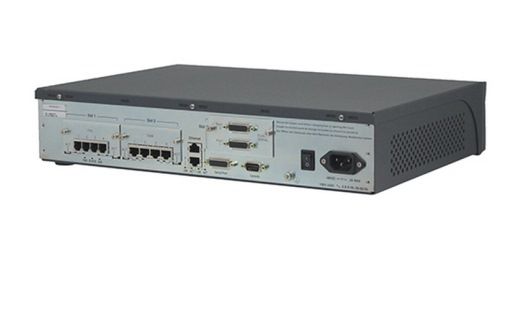NetPerformer - SDM-9220
Satellite Router and Legacy Interface Converter
Satellite and WAN Swiss Army Knife
The SDM-9220 NetPerformer is a high-performance Data and Voice Router. The SDM 9220 Integrated Access Router maximizes network performance and provides superior convergence capabilities to ensure efficient and secure transport of multiple communications services. With a range of interfaces to connect automation and metering equipment, NetPerformer enables deployment over copper, fiber, microwave, and satellite access infrastructure
Product Information
MULTI-PROTOCOL SUPPORT
NetPerformer’s leading compression technology, as well as its multiplexing and prioritization capabilities, make it the product of choice for converged voice & data applications over satellite networks. Its ability to support legacy protocols and IP data makes it ideal for Government, Military, Oil & Gas, Industrial, and Multiservice VSAT applications.
ENHANCED SATELLITE ACCESS CAPABILITIES
NetPerformer can be deployed with SCPC, TDMA, and IP broadband satellite technologies along with SkyPerformer®, our satellite optimization solution. Carriers can operate a hybrid satellite/terrestrial topology over a single platform, reducing costs and minimizing complexity.
AWARD-WINNING COMPRESSION TECHNOLOGY
Memotec’s PowerCell® provides high-compression voice & data transport over any WAN infrastructure. PowerCell QoS is combined with IP Precedence TOS bit and 802.1p/q support to provide end-to-end QoS. Users can define up to eight classes of service with 16 different levels of prioritization to ensure that mission-critical applications always receive sufficient bandwidth.
Key Features
- Support for T1, E1, J1, and Serial Network Interfaces including RS-232, RS-530, V.35, and X.21
- Support for Microwave and Satellite Networks in Point to Point and Multi-Point Topologies with SkyPerformer® - SCPC, and TDMA
- Support for a low form factor - 2U High
- Support for Analog Voice interfaces - FXO, FXS, and E&M
- Support for Digital Voice Interfaces - T1, E1, J1, PRI and BRI
- Low power consumption - Less than 70 watts
- AC or DC Power Supplies
- Support for Legacy Data Protocols both Asynch and Synch - ENQ/ACK, XON/XOFF, transparent, PPP, BDLC, HDLC, SDLC, X.25, X.25 over Frame Relay annex F/G, COP, BSC, VIP, IBM/RJE, Uniscope, Poll/ Select, Siemens Nixdorf, JCA, Zengin, RFC-1490, UNI-DTE, UNI-DCE
- Supports IP Routing and Bridging - IP RIP V1/V2 or Static, OSPF, NAT, IP Multicast IGMP V1/V2 PIM-DM, BootP/DHCP relay, DHCP client, IPX RIP, and SAP, LLC2, 802.1p/q prioritization and VLAN, 802.1D Spanning Tree Protocol (STP), MAC Layer
- Supports FAX - FAX Relay: Group 3 FAX over PowerCell. Super G3 configurable to pass through or fallback to G3. Group 4 FAX and another non-voice bearer ISDN channel at 64K
- Supports Modem Relay - V.32bis demodulation up to 14.4Kbps, STU-III secure phones over PowerCell, modem pass-through (G.711) for other modems
- Supports Voice traffic routing with alternates destinations and digits manipulation using local mapping tables, locally switched TDM calls (hairpin)\
- Supports Voice Signaling and Conversion - ISDN and QSIG T1/E1 PRI and BRI signaling: EuroISDN/ETSI, National, and Japan, T1 signaling: robbed bit signaling, CCS transparent, SS7 transport with idle filtering and spoofing, E1 signaling: CAS, CCS transparent, SS7 transport with idle filtering, Digital CAS Signaling types: Immediate, Wink, FXO, FXS, FXO ground, FXS ground, E1/R2 (compelled, semi-compelled, DTMF), PLAR, custom (9230 only), Mu-law or A-law coding
- Compliant - EMC - Emission FCC Part 15, Class B EN 55022:1998 + A1 + A2, AS/NZS CISPR22, EMC - Immunity EN 55024:1998 + A1 + A2, Safety IEC 60950-1, EN 60950-1, UL 60950-1, CSA C22-2 N°60950-1, AS/NZS 60950, Telecom - Digital FCC Part 68 + TIA-968-A, IC CS-03 Issue 9 - Part 2 and Part 6, AS/ACIF S016, AS/ACIF S038, TBR 1 + TBR 2, TBR 3, TBR4, TBR 12 + TBR 13, Telecom - Analog FCC Part 68 + TIA-968-A, IC CS- 03 Issue 8 - Part 1, AS/ACIF S002, TBR 15 + TBR 17, TBR 21
- Lower Power Cost - Up to 80% less power consumption compared to older technology
Applications
- Satellite and VSAT Applications
- Utilities
- Carriers and Service Providers
- Converging legacy and IP networks
- Mining, Oil and Gas Applications
- Signaling Conversion
- Military Applications
- Reduce power consumption with the replacement of existing power-hungry equipment
Specifications
| NetPerformer SDM-9220 | |||||
| Capacity | Telephony | Up to 8 FXS/FXO or E&M channels per unit | |||
| Data | Up to 3 serial data ports, or 1 serial and 4 T1 or E1 data interfaces (up to 124 logical ports) | ||||
| Link Port | Speed | -With data compression disabled: 8 Mbps/1 port, 2 Mbps/other ports -With data compression enabled: Up to 2 Mbps -*Maximum speed is protocol dependent |
|||
| Physical | System | -Auto-sensing power 100-240 VAC, 50/60 Hz, 65 W maximum -48 VDC -1 serial port (user or link), DTE or DCE, HD26F connector, compatible with RS232/V.24, V.35, X.21/V.11, RS449/V.36, RS-530, internal/external clocking -2X 10/100Base-T Ethernet (RJ-45 connectors) -1 DSP connector per unit -2 expansion slots |
|||
| Chassis | Stand-alone base unit, 19” rack mount | ||||
| Dimensions | 3.5” x 16.8” x 12.2” (89 x 427 x 310 mm) | ||||
| Weight | 9.9 lbs (4.5 kg) | ||||
| Environmental | Operating Temperature | 0° to 50°C / 32° to 113°F | |||
| Storage Temperature | -20º to 65ºC / -4° to 149°F | ||||
| Relative Humidity | 0% to 95%, noncondensing | ||||
| Software Option | SkyPerformer, TCP/IP acceleration, SIP (Eurocae WG67 ED-136/137), IP Header Compression, and Link Delay Compensation (LDC) | ||||
| Optional Interface Modules | Analog Telephony | -2 and 4-port FXS and FXO modules with onboard DSP (software-controllable impedance, RJ-11 connector) -4-port E&M module with onboard DSP (2 or 4-wire, types I, II, or V, 600 ohms, RJ-48 connectors) -4-wire Push to Talk (PTT) option available |
|||
| Digital | Single & dual port T1/E1 (software configurable, RJ48 connectors, adapter cable required for BNC E1-75, NT/TE) | ||||
| Data | 2-port universal serial WAN interface (user or link), DTE or DCE, HD26F connector, interface compatible with RS-232/V.24, V.35, 21/V.11, RS- 449/V.36, RS530, internal/external clocking | ||||
| DSP | DSP modules supporting up to 120 voice channels | ||||
| Network | -Network topology: Mesh, hierarchical, star, point-to-point, satellite point-to-point/multipoint -Automatic node discovery and rerouting with least cost metric routing -Automatic load balancing, bandwidth on demand (over leased line), dial back-up, time-of-day connect -QoS: 8 classes of service, 16 priority weights, association to 802.1p and DiffServ TOS bits |
||||
| Data | -Sync: PPP, BDLC, HDLC, SDLC, X.25, X.25 over Frame Relay annex F/G -Legacy Sync: COP, BSC, VIP, IBM/RJE, Uniscope, Poll/Select, Siemens Nixdorf, JCA, Zengin -Frame Relay: RFC-1490, UNI-DTE, UNI-DCE -Asynchronous: ENQ/ACK, XON/XOFF, transparent |
||||
| Telephony | -Voice compression algorithms (5 channels per DSP): ACELP-CN (8 K/6 K), LDCD (16 K), G.711, G.723.1, G.726, and G.729 (available only with the SIP software option) -FAX Relay: Group 3 FAX, Super G3 configurable to pass through or fallback to G3, Group 4 FAX and other non-voice bearers ISDN channel at 64 K -Modem Relay: V.32bis demodulation up to 14.4kbps, STU-III secure phone, modem pass-through (G.711) for other modems -Network signaling: Transparent point-to-point and any-to-any switching, including end-to-end QSIG/ISDN -Analog telephony channels: -FXS - loop and ground start, forward disconnect, caller ID, and local billing tone generation -FXO - loop start, forward disconnect, and caller ID detection -E&M - immediate and wink start, custom -Pulse, DTMF, and MF tone dialing -Voice traffic routing with alternates destinations and digits manipulation using local mapping tables, locally switched TDM calls (hairpin) |
||||
| LAN | -Two IP address per Ethernet port -Ethernet interfaces: Ethernet II and IEEE 802.2, 802.3, SNAP -Standards: IP RIP V1/V2 or Static, OSPF, NAT, IP Multicast IGMP V1/V2 PIM-DM, BootP/DHCP relay, DHCP client, IPX RIP, and SAP, LLC2, 802.1p/q prioritization and VLAN, 802.1D Spanning Tree Protocol (STP), MAC Layer -Filter criteria: Based on protocol, address (source, destination, or SAP), TOS bit/diffServ, or custom filtering |
||||
| Digital Telephony | -ISDN and QSIG T1/E1 PRI and BRI signaling: Euro ISDN/ETSI, National, and Japan -T1 signaling: robbed bit signaling, CCS transparent, SS7 transport with idle filtering and spoofing -E1 signaling: CAS, CCS transparent, SS7 transport with idle filtering -Digital CAS Signaling types: Immediate, Wink, FXO, FXS, FXO ground, FXS ground, E1/R2 (compelled, semi-compelled, DTMF), PLAR, custom (9230 only) -Mu-law or A-law coding |
||||
| Compliance and Agency Approval | Complies with or has obtained regulatory agency approval at least the following standards: -EMC – Emission: (Class B) FCC Part 15, EN 55022:2010 (UAC version only), AS/NZS CISPR22 -EMC – Immunity: EN 55024:2010 (UAC version only) -Safety: IEC 60950-1:2005 + A1 (UAC version only), EN 60950-1:2006 + A11 + A1 + A12 (UAC version only), UL 60950-1, CSA C22-2 N°60950-1, AS/NZS 60950-1 -SDM-9220/9230: Telecom – Digital: FCC Part 68 + TIA-968-A, IC CS-03 Issue 9 - Part 2 and Part 6, AS/ACIF S016, AS/ACIF S038, TBR 1 + TBR 2, TBR 3, TBR4, TBR 12 + TBR 13 -SDM-9220/9230: Telecom – Analog: FCC Part 68 + TIA-968-A, IC CS- 03 Issue 9 - Part 1, AS/ACIF S002, TBR 15 + TBR 17, TBR 21 -SDM-8400: TBR 1 + TBR 2 |
||||
| Network Management | SNMP management via IPSwitch WUP (WhatsUp Professional) for Windows -Menu-driven async console port (VT-100) via RJ-45 connector, auto-sensing DTE/DCE, speed up to 115,200 bps -Remote Telnet access to the command port -Traps, traces, and extended statistics -Web server interface for local or remote web browser access |
||||
Have more questions about Network Attached Storage products and solutions? Call us at 410-583-1701 or email us at questions@pulsesupply.com.

